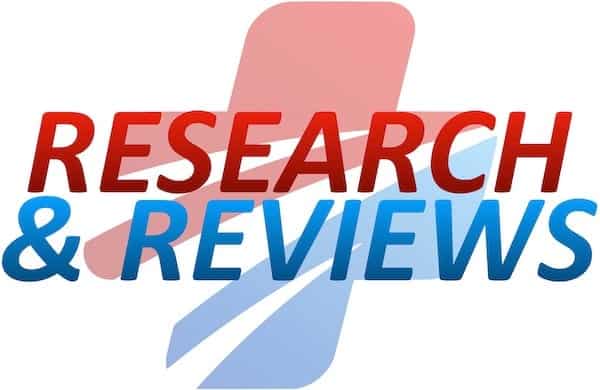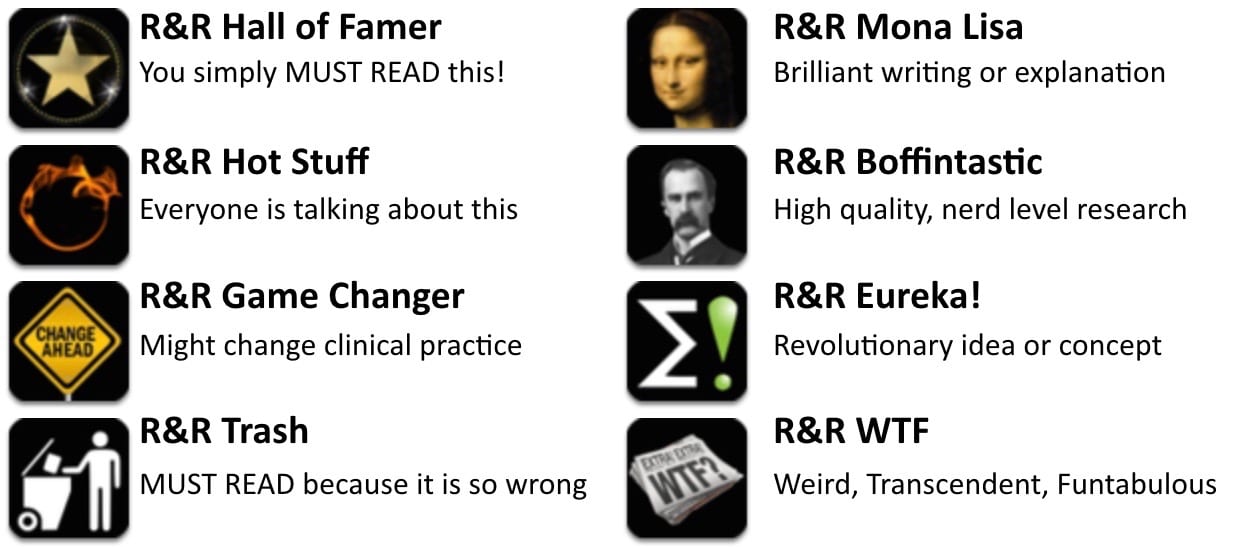R&R In The FASTLANE 040
Welcome to the 40th edition of Research and Reviews in the Fastlane. R&R in the Fastlane is a free resource that harnesses the power of social media to allow some of the best and brightest emergency medicine and critical care clinicians from all over the world tell us what they think is worth reading from the published literature.
This edition contains 10 recommended reads. The R&R Editorial Team includes Jeremy Fried, Nudrat Rashid, Soren Rudolph, Anand Swaminathan and, of course, Chris Nickson. Find more R&R in the Fastlane reviews in the : Overview; Archives and Contributors
This Edition’s R&R Hall of Famer
Alikhan R et al. The acute management of haemorrhage, surgery and overdose in patients receiving dabigatran. Emerg Med J. 2014 Feb;31(2):163-8. PMID 23435652
- With its more predictable pharmacokinetics and a reduced risk of intracranial haemorrhage dabigatran is an attractive alternative to Warfarin. But unlike warfarin, there is no reversal agent and measurement of the anticoagulant effect is not ‘routine’ leading to nihilistic beliefs that bleeding patients overdosed on dabigatran are in dire straits. This great review on dabigatran emergencies reviews treatment options and suggested a treatment algorithm.
- Recommended by Soren Steemann Rudolph
Sharifi M et al – “MOPETT” Investigators. Moderate pulmonary embolism treated with thrombolysis (from the “MOPETT” Trial). the Am J Cardiol. 2013 Jan 15;111(2):273-7. PMID 23102885
- Consider 1/2 dose tPA in submassive PE ?
- In this study the role of a “1/2 dose” thrombolysis was evaluated for the reduction of pulmonary artery pressure in moderate PE. A total of 121 patients with moderate PE received either tissue plasminogen activator plus anticoagulation or anticoagulation alone with the primary end points of pulmonary hypertension and the composite end point of pulmonary hypertension and recurrent PE at 28 months. The results suggested that the ½ dose or “safe dose” thrombolysis was safe and effective in the treatment of moderate PE, with a significant immediate reduction in the pulmonary artery pressure that was maintained at 28 months.
- Recommended by Salim R. Rezaie, MD
LeRoux P. Haemoglobin management in acute brain injury. LeRoux, P. Curr Opin Crit Care. 2013 Apr;19(2):83-91. PMID 23385374
- Nice review summarising the debate on chosing the best haemoglobin transfusion trigger for acute neurocritical care (focus on TBI, SAH and acute ischaemic stroke. Bit repetitive in the middle segment. Discusses threshold numbers, outcomes, context and risks.
- Recommended by Matthew Mac Partlin
Goto Y et al. Neurological outcomes in patients transported to hospital without prehospital return of spontaneous circulation after cardiac arrest. Critical Care 2013; 17:R274 PMID 24252433
- If there’s no ROSC in the field, the chance of achieving good neurologic status is minimal. Survivors were 3-4 times more likely to have a poor neurologic outcome (i.e. severe cerebral disability, coma or brain death) than a good one (1.89% vs. 0.49%).
- Recommended by Anand Swaminathan
Carlson JN, Brown CA. Does the Use of Video Laryngoscopy Improve Intubation Outcomes? Ann Emerg Med. 2014 Mar 10. PMID: 24635989
- Video laryngoscopy provides superior views of the glottic opening compared with direct laryngoscopy but does not improve the overall rate of intubation success. For difficult airways, video laryngoscopy decreases the time required for intubation.
- Recommended by Jeremy Fried
Warren SA et al. Adrenaline (epinephrine) dosing period and survival after in-hospital cardiac arrest: a retrospective review of prospectively collected data. Resuscitation 2014; 85: 350-8. PMID: 24252225
- The effects of different dosing periods of adrenaline (epinephrine) remain unclear. In this retrospective review of prospectively collected data investigators sought to evaluate the association between epinephrine average dosing period and survival to hospital discharge in adults with an in-hospital cardiac arrest. A less frequent adrenaline dosing (6 to <7 min/dose vs 4 to <5 min per dose) was associated with improved survival to discharge. This is more indirect evidence that adrenaline, at least as recommended by current the current ACLS guidelines, is harmful in cardiac arrest patients.
- Recommended by Anand Swaminathan
Fröhlich S et al. Acute respiratory distress syndrome: current concepts and future directions. Anaesth Intensive Care. 2013 Jul;41(4):463-72. PMID 23808504
- Where are we up to on ARDS interventions? Sit back, relax and let the Irish intensivists paint you a picture. A handy review if you are about to sit some exams.
- Recommended by Matthew Mac Partlin
Teismann NA et al. The Ultrasound-guided “Peripheral IJ”: Internal Jugular Vein Catheterization using a Standard Intravenous Catheter. J Emerg Med. 2013 Jan;44(1):150-4. PubMed PMID: 22579025
- We can put a peripheral IV in the internal jugular – but should we?
- Some patients just have no IV access – no superficial peripherals, no deep peripherals, no external jugular veins. In a critical emergency, this is the perfect time for an intraosseous line. But, what about the situation where IV access is simply necessary, but not urgent? Placing a central line is the last thing we’re interested in doing – draping, opening a costly central line kit, billing for an expensive procedure, exposing them to risks of over-the-wire techniques in the central circulation.This technique, described formally here by folks from Highland Hospital, involves placing a standard, peripheral catheter into the internal jugular vein under ultrasound guidance. While I think this is a fantastic idea – much faster and less expensive than a full multi-lumen central line set-up – I wouldn’t characterize it as “risk-free”, either. The nine cases in this year-long review all demonstrated a lack of complications, but more data would help refine the procedural risks.
- Recommended by Ryan Radecki
Rapid blood-pressure lowering in patients with acute intracerebral hemorrhage. The INTERACT Investigators. Engl J Med. 2013 Jun 20;368(25):2355-65. PubMed PMID: 23713578
- Whether rapid lowering of elevated blood pressure would improve the outcome in patients with intracerebral hemorrhage remains elusive. In this study 2839 patients with spontaneous intracerebral hemorrhage and elevated systolic blood pressure received treatment to either a target systolic level of <140 mm Hg or <180 mm Hg within 1 hour with the use of agents of the physician’s choosing. The Authors did not find the hoped improvements in mortality or severe disability with intensive BP lowering, but did see an improvement in functional outcomes, and no increased harm. So lower away!
- Recommended by Zach Repanshek
Biondo S et al. Outpatient versus hospitalization management for uncomplicated diverticulitis: a prospective, multicenter randomized clinical trial (DIVER Trial). Ann Surg. 2014 Jan;259(1):38-44. PMID 23732265
- The DIVER trial is a prospective randomized clinical control trial validating what we already do in common clinical practice in sending home uncomplicated diverticulitis. 132 individuals underwent randomization in a 1:1 fashion to either inpatient treatment with parenteral antibiotics or sent home on oral antibiotics. Patients had to be uncomplicated (radiographically defined + symptoms relief, no abscess, no breastfeeding or pregnancy, no cognitive/social impairment, no persistent vomiting, no previous antibiotic usage for diverticulitis) in order to meet inclusion criteria. The primary outcome was treatment failure rates whereas the secondary outcomes were quality of life measures. At the end of the study there were no differences between the two groups. The study confirms that our current practice of not admitting uncomplicated diverticulitis presuming the patient has good outpatient follow-up is a safe and cost-effective practice. Interestingly the antibiotic of choice for outpatients was Augmentin alone as opposed to the reflexively given dual therapy (cipro/flagyl) that many choose to use.
- Recommended by William Paolo
Senior Consultant Anesthesiologist, Traumemanager and PHEM doctor. Dedicated to trauma resuscitation, prehospital care and airway management. Barometerbarn | @SorenRudolph |









